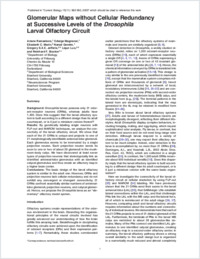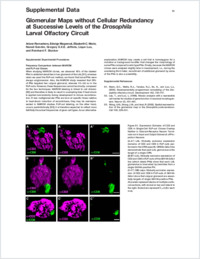Glomerular Maps without Cellular Redundancy at Successive Levels of the Drosophila Larval Olfactory CircuitGlomerular Maps without Cellular Redundancy at Successive Levels of the Drosophila Larval Olfactory Circuit
- Ramaekers, Ariane Department of Biology, University of Fribourg, Switzerland
- Magnenat, Edwige Department of Biology, University of Fribourg, Switzerland
- Marin, Elizabeth C. Department of Biological Sciences, Stanford University, California, USA
- Gendre, Nanaë Department of Biology, University of Fribourg, Switzerland
- Jefferis, Gregory S. X. E. Department of Biological Sciences, Stanford University, California, USA - Neurosciences Program, Stanford University, Stanford, California, USA
- Luo, Liqun Department of Biological Sciences, Stanford University, California, USA - Neurosciences Program, Stanford University, Stanford, California, USA
- Stocker, Reinhard F. Department of Biology, University of Fribourg, Switzerland
-
19.05.2005
Published in:
- Current Biology. - 2005, vol. 15, no. 11, p. 982-992
English
Background: Drosophila larvae possess only 21 odorant-receptor neurons (ORNs), whereas adults have 1,300. Does this suggest that the larval olfactory system is built according to a different design than its adult counterpart, or is it just a miniature version thereof? Results: By genetically labeling single neurons with FLP-out and MARCM techniques, we analyze the connectivity of the larval olfactory circuit. We show that each of the 21 ORNs is unique and projects to one of 21 morphologically identifiable antennal-lobe glomeruli. Each glomerulus seems to be innervated by a single projection neuron. Each projection neuron sends its axon to one or two of about 28 glomeruli in the mushroom-body calyx. We have discovered at least seven types of projection neurons that stereotypically link an identified antennal-lobe glomerulus with an identified calycal glomerulus and thus create an olfactory map in a higher brain center. Conclusions: The basic design of the larval olfactory system is similar to the adult one. However, ORNs and projection neurons lack cellular redundancy and do not exhibit any convergent or divergent connectivity; 21 ORNs confront essentially similar numbers of antennal-lobe glomeruli, projection neurons, and calycal glomeruli. Hence, we propose the Drosophila larva as an “elementary” olfactory model system.
- Faculty
- Faculté des sciences et de médecine
- Department
- Département de Biologie
- Language
-
- English
- Classification
- Biological sciences
- License
-
License undefined
- Identifiers
-
- RERO DOC 5096
- DOI 10.1016/j.cub.2005.04.032
- Persistent URL
- https://folia.unifr.ch/unifr/documents/299924
Other files
Statistics
Document views: 147
File downloads:
- Texte intégral: 446
- Texte intégral: 174

